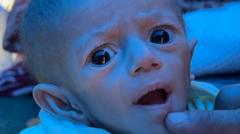In the devastated landscape of Gaza, a sense of despair persists as residents cope with the relentless ramifications of the ongoing Israeli blockade. The harrowing situation is epitomized by the story of baby Siwar Ashour, who at five months weighs just over two kilograms, a stark reality reflecting the severe food crisis affecting countless families in the region. Journalists documenting the conditions reveal scenes of empty streets filled with the heart-wrenching sounds of hungry children, as families wait in vain for essential supplies.
The local cameraman broadcasting the situation describes the emotional toll of witnessing their suffering firsthand. Siwar, discharged from Nasser hospital, requires a special milk formula due to an allergic reaction, which has been rendered almost impossible to obtain. With aid shipments stifled by the blockade, reaching any semblance of stability seems increasingly out of reach for infants and their families like Siwar’s mother, Najwa, and grandmother, Reem.
Najwa recounts the ongoing struggle to secure enough food to feed herself and to care for her daughter. The reality of life in Gaza is further complicated by rampant malnutrition, which has made it nearly impossible for many mothers to breastfeed their children. Families like Najwa's now face agonizing decisions over which fundamental necessities they can afford, with milk and even basic diapers becoming luxuries they can rarely obtain.
Reports from the United Nations, human rights organizations, and foreign governments paint a grim picture, contradicting claims from the Israeli military that no food shortages exist. The UN Secretary General articulated the severity of the situation, likening the aid made available to a mere "teaspoon" for a population on the brink of disaster. For the nearly two million residents of Gaza, including vulnerable infants and malnourished mothers, each day is a battle for survival amid the incessant clamor of conflict.
While politicians engage in debates, the human experiences of loss and hardship remain overshadowed. In the fractured hope of future assistance, Najwa poignantly states that the focus is only on navigating each moment as it comes: “One does not think about the future or the past. There is only the present moment and how to survive it.” The tragedy of their stories encapsulates the urgency of a humanitarian response to lift the veil of suffering that envelops Gaza today.
The local cameraman broadcasting the situation describes the emotional toll of witnessing their suffering firsthand. Siwar, discharged from Nasser hospital, requires a special milk formula due to an allergic reaction, which has been rendered almost impossible to obtain. With aid shipments stifled by the blockade, reaching any semblance of stability seems increasingly out of reach for infants and their families like Siwar’s mother, Najwa, and grandmother, Reem.
Najwa recounts the ongoing struggle to secure enough food to feed herself and to care for her daughter. The reality of life in Gaza is further complicated by rampant malnutrition, which has made it nearly impossible for many mothers to breastfeed their children. Families like Najwa's now face agonizing decisions over which fundamental necessities they can afford, with milk and even basic diapers becoming luxuries they can rarely obtain.
Reports from the United Nations, human rights organizations, and foreign governments paint a grim picture, contradicting claims from the Israeli military that no food shortages exist. The UN Secretary General articulated the severity of the situation, likening the aid made available to a mere "teaspoon" for a population on the brink of disaster. For the nearly two million residents of Gaza, including vulnerable infants and malnourished mothers, each day is a battle for survival amid the incessant clamor of conflict.
While politicians engage in debates, the human experiences of loss and hardship remain overshadowed. In the fractured hope of future assistance, Najwa poignantly states that the focus is only on navigating each moment as it comes: “One does not think about the future or the past. There is only the present moment and how to survive it.” The tragedy of their stories encapsulates the urgency of a humanitarian response to lift the veil of suffering that envelops Gaza today.



















